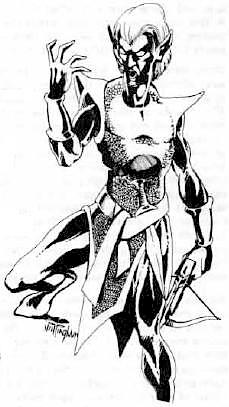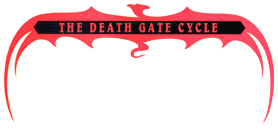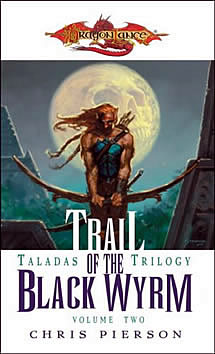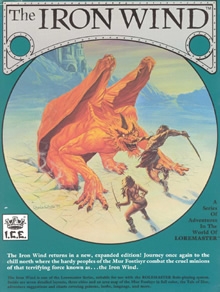
Earthdawn is a fantasy role-playing game, originally produced by FASA in 1993. In 1999 it was licensed to Living Room Games, which produced the Second Edition. It was licensed to RedBrick in 2003, who released the Classic Edition in 2005 and the game's Third Edition in 2009. The license is now held by FASA Games, Inc., who have released the Fourth Edition, with updated mechanics and an advanced metaplot timeline. Vagrant Workshop released the Age of Legend edition in 2016 using alternative rules-lite mechanics.

The drow or dark elves are a dark-skinned and white-haired subrace of elves connected to the subterranean Underdark in the Dungeons & Dragons fantasy roleplaying game. The drow have traditionally been portrayed as generally evil and connected to the evil goddess Lolth. However, later editions of Dungeons & Dragons have moved away from this portrayal and preassigned alignment. More recent publications have explored drow societies unconnected to Lolth.

The Death Gate Cycle is a seven-part series (heptalogy) of fantasy novels written by Margaret Weis and Tracy Hickman. The main conflict is between two powerful races, the Sartan and the Patryns, which branched off from humans following a nuclear/anti-matter holocaust. Centuries prior to the events of the series, the Sartan attempted to end the conflict by sundering the Earth into four elemental realms, and imprisoning the Patryns in a fifth prison world, the Labyrinth. The Sartan took up stewardship of the elemental realms, but soon mysteriously lost contact with each other and disappeared. Centuries later, a Patryn known as Xar escaped the Labyrinth, and started returning to the Labyrinth to rescue others. He learned how to access the other worlds, using the eponymous portal called the Death Gate, and dreamed of freeing all his people from the Labyrinth and conquering the other worlds. The books follow the fiercely independent Haplo, a Patryn agent sent to scout the elemental worlds and throw them into chaos in preparation for his Lord's conquest of them. Weis and Hickman created five distinct fantasy worlds during the course of the series, along with developing the cultures of five major races: the unique Patryn and Sartan, and the common fantasy races of dwarves, elves, and humans.
Birthright is a Dungeons & Dragons campaign setting that was first released by TSR in 1995. It is based on the continent of Cerilia on the world of Aebrynis, in which the players take on the role of the divinely-empowered rulers, with emphasis on the political rulership level of gameplay. The setting revolves around the concept of bloodlines: divine power gained by heroes and passed to their descendants. Characters with a bloodline create an aura of command known as Regency, which is measured in the game using regency points or RP. Using regency, characters acquire a domain composed of provinces and holdings. The development of these domains is as much a part of the game as development of the characters. The game uses three-month domain turns to model actions of rulers over nations in much the same way as Dungeons & Dragons uses combat rounds to simulate time to model the characters' actions in battle. In 1996, Birthright won the Origins Award for Best Roleplaying Supplement of 1995.

In many works of modern fantasy, elves are depicted as a race or species of pointy-eared humanoid beings. These depictions arise from the álfar of Norse mythology influencing elves in fantasy as being semi-divine and of human stature, whose key traits are being friendly with nature and animals. However, this differs from Norse and the traditional elves found in Middle Ages folklore and Victorian era literature.

The Palladium Fantasy Role-Playing Game is a game produced by Palladium Books. It is set in the Palladium world some 10,000 years after a great war between the elves and dwarves. First published in July 1983 as The Palladium Role-Playing Game, the Palladium Fantasy Role-Playing Game saw a second edition in April 1996. The two are largely compatible, though the second edition uses a later iteration of Palladium's ruleset to be more compatible with the rest of their Megaverse.
The fictional races and peoples that appear in J. R. R. Tolkien's fantasy world of Middle-earth include the seven listed in Appendix F of The Lord of the Rings: Elves, Men, Dwarves, Hobbits, Ents, Orcs and Trolls, as well as spirits such as the Valar and Maiar. Other beings of Middle-earth are of unclear nature such as Tom Bombadil and his wife Goldberry.

The elf is a humanoid race in the Dungeons & Dragons fantasy role-playing game, one of the primary races available for player characters, and play a central role in the narratives of many setting worlds of the game. Elves are described as renowned for their grace and mastery of magic and weapons such as the bow and sword. Becoming physically mature by the age of 25 and emotionally mature at around 125, they are also famously long-lived, capable of living more than half a millennium and remaining physically youthful. Possessed of innate beauty and easy gracefulness, they are viewed as both wondrous and haughty by other races in-universe; however, their natural detachment is seen by some as introversion or xenophobia. They were usually portrayed as antagonistic towards dwarves.
Midnight is a campaign setting for the Dungeons & Dragons role-playing game, released under the Open Gaming License. It was published by Fantasy Flight Games from 2003 to 2009.

Trail of the Black Wyrm is a fantasy novel set in the Dragonlance campaign series and is the second of a trilogy about Taladas. The third book in the trilogy is Shadow of the Flame.
Armies of Arcana is a fantasy-based tabletop wargame created by Thane's Games. It is commonly played with 15mm or 28mm scale miniatures representing troops of various fantasy races and creatures. There are 16 core armies that can be played, including elves, dwarves, orcs, and multiple human races, but other armies have been made "official" on the Thane's Games website. Numerous monsters are also available for any army to use in their battles. The background for the game is largely open for individual players to customise themselves and not feel restricted by one "official" account of relations between races. This removes the common problem in miniature wargames of some pairs of players armies having no "excuse" to fight each other. However, a coordinated background development project is under way at the Armies of Arcana forum.
The Strands Series is a series of books and short stories written by Gael Baudino between 1981 and 1994 and published between 1989 and 1997. The majority of the plot occurs in a fictional land named Adria, which is based on Medieval Western Europe, with parts of later books occurring in 1990s Denver, USA. Though many of the locations in Adria are fictional, the geography, culture, and language are realistic depictions of Europe during the 14th-15th centuries. The author describes Adria's placement in this way: "Imagine a slash between France and Germany, and then insert about 300 miles".

Shadow World is a high-fantasy campaign setting situated on the fictional planet of Kulthea. Originally produced for the Rolemaster role-playing game system, Shadow World is fairly compatible with other d100 games such as High Adventure Role Playing (HARP), Middle-earth Role Playing (MERP) or Against the Darkmaster. The setting blends traditional fantasy elements, such as elves, dwarves, and magic, with science fiction, including such elements as space and time travel, and, to a degree, futuristic technology.
In the Shadow World campaign setting, Emer is a continent on Kulthea, where the Grand Campaign takes place. It is the largest contenint on the planet, roughly located within the center of the western hemisphere.
The Hollows series is a series of 16 urban fantasy novels, eight short stories, two graphic novels, and one compendium resource by Kim Harrison, published by HarperCollins Publishers, in an alternate history universe and set primarily in the city of Cincinnati and its suburbs. The alternate history is built upon two premises: the recent open existence of magical and supernatural species, primarily witches, vampires, and werewolves, with the human population; and the historical investment of Cold War military spending in genetic engineering as opposed to the Space Race, which resulted in the accidental release of a genetically modified tomato in the 1960s that killed a significant portion of the human population. The series is set approximately 40 years after this plague, referred to as ”The Turn“ within the series.
Stonehaven is a series of first-run graphic novels and prose novels set in a contemporary urban fantasy city of the same name, in which mythical creatures live openly alongside humans. Created by Kevin Tinsley in the ‘90s, the first volume was published by Stickman Graphics in 2004.
The half-elf is a player character race featured in Dungeons & Dragons and related material.
The Twilight Reign is a five-book series written by Tom Lloyd. The five books in order are: The Stormcaller, The Twilight Herald, The Grave Thief, The Ragged Man, and The Dusk Watchman It follows the fight against the shadow Azaer.
In J. R. R. Tolkien's writings, Elves are the first fictional race to appear in Middle-earth. Unlike Men and Dwarves, Elves are immortal, though they can be killed in battle. If so, their souls go to the Halls of Mandos in Aman. After a long life in Middle-earth, Elves yearn for the Earthly Paradise of Valinor, and can sail there from the Grey Havens. They feature in The Hobbit and The Lord of the Rings. Their history is described in detail in The Silmarillion.

Guilded Age is a 2009 fantasy webcomic about five heroes who have come together to work for a common goal: three squares and a warm bed. Its narrative presents a conflict between warring coalitions based on centuries-old feuds, but the writers claim they intend to "try to focus on what's important." The webcomic is a collaboration of T Campbell, Erica Henderson, and Phil Kahn. T Campbell, the co-writer, has described Guilded Age as a "fantasy dramedy-adventure" Henderson stepped down as the primary artist of the strip at the end of November 2010, with art duties being taken over by John Waltrip.







